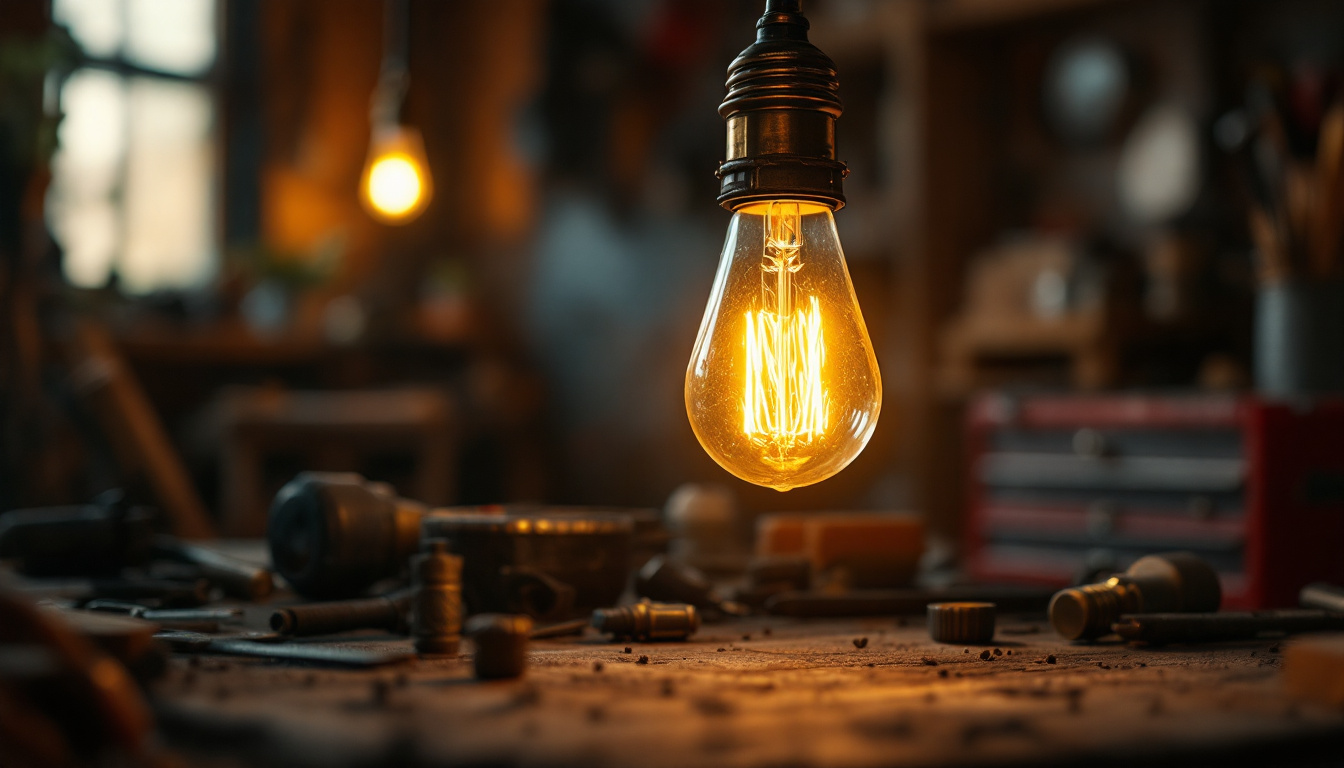
The invention of the light bulb marked a significant turning point in the history of technology and energy consumption. This revolutionary device has not only transformed the way we illuminate our spaces but has also had profound implications for various industries, particularly for lighting contractors. Understanding the evolution of the light bulb and its impact on cost efficiency can help contractors optimize their services and reduce expenses.
The journey of the light bulb began with a series of experiments and innovations by various inventors. These early efforts laid the groundwork for what would eventually become a staple in modern lighting. The initial designs focused on creating a reliable source of light that could be used in homes and businesses alike.
One of the earliest forms of electric lighting was the arc lamp, which provided bright illumination but was impractical for everyday use due to its high energy consumption and safety concerns. As the demand for more efficient lighting grew, inventors began to explore different materials and technologies. Notably, Sir Humphry Davy demonstrated the first electric arc lamp in the early 1800s, showcasing the potential of electric light, although it would take several decades before a practical version could be developed for widespread use.
The breakthrough in light bulb technology came with the development of the incandescent bulb. This design utilized a filament that glowed when an electric current passed through it, providing a warm and inviting light. The incandescent bulb quickly gained popularity, becoming the standard for residential and commercial lighting.
However, the incandescent bulb was not without its drawbacks. It consumed a significant amount of energy and had a relatively short lifespan. As energy costs began to rise, the need for more efficient lighting solutions became increasingly urgent. This led to further innovations, including the introduction of the tungsten filament by Thomas Edison, which improved the bulb’s efficiency and longevity. Edison’s work not only revolutionized lighting but also paved the way for the electrical infrastructure that powers our homes today.
In response to the limitations of incandescent bulbs, newer technologies emerged, including compact fluorescent lamps (CFLs) and light-emitting diodes (LEDs). These alternatives offered longer lifespans and greater energy efficiency, significantly reducing electricity costs for consumers and businesses alike. CFLs, for instance, use about 75% less energy than traditional incandescent bulbs and can last up to ten times longer, making them an attractive option for environmentally conscious consumers.
Today, LED technology is at the forefront of lighting innovation, providing a sustainable and cost-effective solution for contractors and their clients. LEDs not only consume less power but also emit less heat, which enhances safety and reduces cooling costs in indoor spaces. Furthermore, the versatility of LED lighting has led to its adoption in a variety of applications, from residential lighting to streetlights and even intricate architectural designs. Understanding these advancements is crucial for lighting contractors looking to stay competitive in the industry, as the shift towards energy-efficient solutions continues to reshape the landscape of modern lighting.
For lighting contractors, energy efficiency is not just a buzzword; it’s a critical factor that can influence project costs and client satisfaction. The shift towards energy-efficient lighting solutions has significant implications for both contractors and their clients. As the demand for sustainable practices grows, contractors who prioritize energy efficiency can differentiate themselves in a competitive market.
By recommending and installing energy-efficient lighting systems, contractors can help clients reduce their energy bills. This not only enhances customer satisfaction but also positions the contractor as a knowledgeable and responsible service provider. Clients are more likely to return for future projects or recommend services to others when they see tangible savings. Additionally, many clients are now seeking solutions that align with their corporate social responsibility goals, making energy-efficient lighting an attractive option for businesses looking to enhance their brand image.
While the initial investment in energy-efficient lighting may be higher, the long-term savings can be substantial. LED bulbs, for example, consume significantly less energy than traditional incandescent bulbs and last much longer, resulting in fewer replacements and lower maintenance costs. This longevity not only translates to financial savings but also reduces the environmental impact associated with manufacturing and disposing of lighting products.
Contractors can leverage this knowledge to educate clients about the long-term benefits of investing in modern lighting solutions. By presenting a clear cost-benefit analysis, contractors can justify the upfront costs and encourage clients to make informed decisions. Furthermore, many utility companies offer rebates and incentives for the installation of energy-efficient lighting, which can further offset initial costs and make the transition more appealing for clients.
In addition to energy savings, the installation process itself can be optimized to reduce costs. By using advanced lighting technologies, contractors can streamline their operations. For instance, smart lighting systems can be integrated into new or existing projects, allowing for easier control and automation. These systems not only enhance user experience but also provide data analytics that can help clients monitor energy consumption and make adjustments as needed.
Moreover, the adoption of modular lighting systems can simplify installation and reduce labor costs. These systems are designed for quick assembly and disassembly, enabling contractors to complete projects more efficiently without compromising quality. Additionally, training staff on these innovative systems can lead to improved installation techniques and fewer errors, ultimately saving time and resources. As technology continues to evolve, staying updated with the latest advancements will be crucial for contractors aiming to maintain a competitive edge in the industry.
In the rapidly evolving world of lighting technology, staying informed is essential for contractors. New products and innovations are constantly being introduced, and understanding these advancements can provide a competitive edge.
Contractors should invest time in training and professional development to stay updated on the latest trends and technologies. This knowledge not only enhances their skill set but also empowers them to offer clients the best possible solutions. For instance, familiarity with smart lighting systems and energy-efficient LED options can significantly impact project proposals and client satisfaction. Furthermore, as sustainability becomes a focal point in construction and design, being knowledgeable about eco-friendly lighting solutions can set a contractor apart in a crowded market.
Building relationships with manufacturers and suppliers can also provide valuable insights into emerging technologies and industry best practices. Networking with other professionals in the field can lead to collaborative opportunities and shared knowledge, further enhancing a contractor’s expertise. Engaging with local trade associations or joining online forums can facilitate these connections, allowing contractors to exchange experiences and solutions to common challenges.
Participating in industry conferences, workshops, and webinars can also be beneficial. These events often feature expert speakers and provide a platform for discussing new ideas and innovations in lighting technology. Additionally, they can serve as a venue for hands-on demonstrations of cutting-edge products, allowing contractors to experience the latest advancements firsthand. By actively engaging in these learning opportunities, contractors can not only expand their technical knowledge but also foster relationships that may lead to future partnerships or projects, ultimately enhancing their business prospects in a dynamic industry.
For lighting contractors, effectively marketing energy-efficient solutions is key to attracting clients. Many consumers are still unaware of the benefits associated with modern lighting technologies. By creating awareness, contractors can position themselves as leaders in the industry. This can be achieved through informative workshops or community events that focus on the advantages of energy-efficient lighting, such as reduced energy bills and lower environmental impact. Engaging with local businesses and organizations to co-host these events can also enhance visibility and foster community relationships.
Utilizing various marketing channels, such as social media, websites, and local advertising, can help reach a broader audience. Sharing success stories and testimonials from satisfied clients can also build credibility and trust. Additionally, leveraging platforms like Instagram or TikTok to showcase before-and-after transformations of lighting projects can create visually appealing content that resonates with potential customers. By using targeted ads that highlight specific demographics interested in sustainability, contractors can ensure their message reaches the right audience effectively.
Providing educational content, such as blog posts, videos, and infographics, can further engage potential clients. This content can explain the benefits of energy-efficient lighting, how it works, and the potential cost savings. By positioning themselves as knowledgeable resources, contractors can attract more clients who are interested in sustainable solutions. Consider creating a series of webinars that delve into topics like the science behind LED technology or the environmental impact of traditional lighting versus energy-efficient options. This not only educates consumers but also establishes the contractor as an authority in the field.
Many regions offer incentives and rebates for energy-efficient lighting upgrades. Contractors should stay informed about these programs and communicate them to clients. Highlighting available savings can motivate clients to invest in energy-efficient solutions, ultimately benefiting both parties. Furthermore, creating a comprehensive guide that outlines the steps to apply for these incentives can be a valuable resource for clients, simplifying the process and encouraging them to take action. Collaborating with local government or utility companies to promote these programs can also enhance the contractor’s reputation as a proactive advocate for energy efficiency.
The invention of the light bulb has come a long way, evolving from basic incandescent designs to advanced LED technologies. For lighting contractors, understanding this evolution is crucial for optimizing services and reducing costs.
By embracing energy-efficient solutions, staying informed about technological advancements, and effectively marketing their services, contractors can not only enhance their own profitability but also contribute to a more sustainable future. As the demand for energy-efficient lighting continues to grow, contractors who adapt and innovate will be well-positioned to thrive in the industry.
In a world where energy consumption is under scrutiny, the role of lighting contractors is more critical than ever. By prioritizing efficiency and sustainability, they can lead the charge towards a brighter, more cost-effective future for all.
Ready to revolutionize your lighting solutions and elevate your projects while keeping costs down? Look no further than LumenWholesale, where we specialize in providing contractors with the highest quality, spec-grade lighting products at unbeatable wholesale prices. Say goodbye to local distributor markups and hello to our extensive selection that meets the highest industry standards. With free shipping on bulk orders, you’re guaranteed to get the best value for premium lighting—no hidden fees, no compromises. Make the smart choice for your business and contribute to a brighter, more sustainable future. Wholesale Lighting at the Best Value is just a click away. Experience the LumenWholesale difference today!

Discover the transformative power of potted lights in creating energy-efficient spaces.

Discover the key factors that distinguish top lighting contractors when it comes to Tube T8 LED installations.

Discover the ultimate guide to outdoor wall mounted solar lanterns, exploring their benefits, installation tips, and design options to enhance your home’s exterior lighting sustainably and stylishly..

Discover the must-know essentials for lighting contractors in our comprehensive guide on wall light LED outdoor installations.